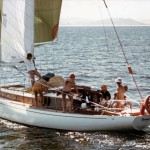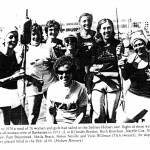| Barbarian | |
|---|---|
 | |
| Country | Australia |
| Boat Type | Sloop |
| Sail Number | 206 MH206 |
| Club | Middle Harbour Yacht Club Royal Prince Alfred Yacht Club |
| LOA | 11.58m, 38f |
| LWL | 8.83m, 29f |
| Year Build | 1970 (age 54) |
| Owner (s) | Matthew Baxter |
| Former Owners | A. F. (Adrian) Alle John Shaw |
| Builder(s) | R.C. Davies in New Zealand |
| Former Crew | Helen Neville Lesley Brydon Nancy Shaw Narelle Cox Pam Brinsmead Ruth Reinhardt Sheila Beach Vicki Willman |
Barbarian
Sydney to Hobart 1975 | In 1975, Vicky Willman skippered the first all female crew to Hobart on Barbarian MH206. It was in the time that it was hard for females to find a boat to go ocean racing on, so Vicky Willman decided to charter a boat and take along the all-female crew. You can read all about their adventurous trip in the article below by one of the crew: Lesley Brydon. The crew were: Skipper: Vicki Willman Navigator: Sheila Beach Crew: Pam Brinsmead, Helen Neville, Ruth Reinhardt, Narelle Cox, Nancy Shaw (wife of owner John Shaw) and Lesley Brydon. Ladies Day in the Tasman SeaLadies' Day in the Tasman Sea Modern Boating, March 1976 An eighteen foot sailing boat was sank sliced in two ... it splintered and sank within seconds. The all-girl crew aboard Barbarian were busy in the cockpit and scarcely aware of their involvement in the incident until three terrified, bedraggled survivors clambered on to the foredeck. Skipper Vicki Willman at the helm looked up in amazement! "Who are these people? What are they doing here?" And in the next second .. "Get them off.. Get them OFF", she was yelling and would likely have them tossed right back into the sea had not a Police boat drawn alongside and plucked them smartly away. Vicky had not spent a whole year of planning and hard work to launch the first all-girl attempt to sail the Hobart Race, just to be foiled right here at the start by a carelessly driven spectator craft. "It's alright girls, your boat is OK" the police reassured us and quelled the slight air of panic that was developing on board Barbarian. "Remember girls â¦.Hobart", they said. "Now get going". Sure we were ok, but we no longer had any pulpit of liferails and the forestay had a menacing looking bend at its base. Yet half an hour later we had settled down and thrown off the bits and pieces of stay boat that hung around the decks. A torn segment of sail her and a foot or two of mast there, and shapeless chips of wood .. all that remained of the luckless sailing boat. Our only casualty appeared to be the lookout girl who was sitting on the pulpit at the time of the accident, apparently looking somewhere else. She now looked as though she was about to have a nervous breakdown and retired below in a state of shock. It was a rotten start to the race; made worse by the fact that it had been we (the girls) involved in the accident when there were skippers around who would have considered it their finest movement to sink a member of the spectator fleet. After four days alone at sea the girls were all in agreement. There was no time whatever that any of us had wished we had a man on board. There were occasions, however, when we could have done with a mechanic . or an engineer .. or an electrician or anyone at all really who knew something about motors or electrics. Even before the start we had one such moment, as we motored out of Rushcutters Bay with the alternator light glowing bright red, refusing to go out. Strange, we thought, that hasn't happened before. A police launch was passing and we called for advice. "What's it mean when your alternator light won't go out?" "I suppose it means that your alternator has had it," the sergeant called back, offering his services to investigate. But there was nothing he could do. Someone had dropped a blob of solder on one of the terminals and the alternator was shorting. It was too big a job to fix on the spot with less than an hour to the start, so that was that. We could not charge the batteries. I reflected on the dark warning of a Cruising Yacht Club of Australia official who said to me before the race: "Now get this straight. I would like to see this boat get to Hobart like all the others, even if it does take three weeks to do so. But if it doesn't and if you girls miss so much as one single radio sked, there will be nobody anywhere who will take a very sympathetic view. Do you understand?" We understood. We had two fully charged batteries which under any foreseeable conditions should be enough to sustain communications to Hobart. But that would be all. We could not use the power for any other purpose, except navigation lights. We allowed ourselves the use of the compass light only but on the second day it packed up too. Ruth Rynehart, an amateur electrician, made some attempt to fix it but gave up after receiving two electric shocks and decided that it was probably only the bulb that had blown. Since we didn't have a spare one, there was not a lot she could do. After that we faced the tedious task of perching by the compass all night holding a torch for the helmsman. Fortunately someone had the foresight to bring lots of batteries. But we didn't miss a radio sked. Navigator Sheila Beach was there every time with our position, right to the nearest pinpoint. And she found Tasmania for us too, something that all navigators were not able to claim. Well, not in the first attempt anyway. But Sheila does seem to have most of the characteristics of a good navigator. Blind as a bat and a chain smoker who does not appear to require sleep. She worked and worried her way to Hobart on two cartons of Rothmans and a flagon of vitamin tonic. After tacking out to the rhumb line from Sydney Heads we headed south and the first morning found us juggling the spinnaker on a light sheet and moaning with futility during extended periods of maddening calm. By afternoon the breeze had freshened, and we were jolted into action when a sudden gust ripped the kicker block out of the deck. The mainsail had unfurled before the start to reveal daylight through a small hole which despite hours of anxious preparation had escaped our notice. The hole spread like a disease and Nancy Shaw, wife of the owner, tended it, continually adding strips of sticking plaster to cover the damage. But her role of nursemaid later turned to one of patient During a lightning spinnaker peel which was finally completed in just under 45 minutes, the spinnaker pole carne away from the mast and fell to the deck with a crash. Nancy was standing directly below. The sharp point of the parrot beak was buried in her skull and she howled with pain though there wasn't a tear. Seeing stars, she clutched her head, but the blood spilled through her fingers and coursed down her face. Fearing the worst - that we would have a concussion case on our hands and be forced to retire from the race - the rest of the crew struggled to tame the spinnaker and waited with great apprehension for nurse Pam Brinsmeads's diagnosis. She tended to Nancy's wound with great proficiency, repeatedly checking her pupils and pulse. No indications of concussion, thank goodness, and alter a long night's rest Nancy came up smiting again. But I thought of poor John Shaw, worried sick about his boat. It was Just as well he couldn't know what was happening to his wife. As the nor'-easter strengthened to around 20 knots the helm became heavier and harder for a 'mere' girl to control. With the big swell under her tail, Barbarian had a will of her own, riding high on the waves then skidding down again with a rush that took the speedo right off the clock. As I took my half hour trick at the wheel. I constantly felt like a pilot at the controls of an aeroplane with one wing. The spinnaker was working overtime and we watched it nervously. "The sail instructions say it won't hold over 25 knots" Helen Neville pointed out. "And just look at those instruments. I know you're supposed to have guts to go ocean racing, but it seems to me that it ought to come down." The speedo registered a steady 10 knots and even more surfing. It was a real fight at the helm and the spinnaker was a monster in control. "You're right. It should come down. But with this sea and this speed and no pulpit up there, I'd rather you go up on the foredeck than me." But we needn't have worried. As an old sailing mentor of mine always says, sails know themselves when they've had enough. They can generally take themselves off. And with a crash and a bang and a corresponding whiplash, the brace busted, and the spinnaker flew skywards. We dragged it down and settled for an altogether happier rig, a poled-out genoa which still delivered 9 to 10 knots. Barbarian shuddered with relief arid settled down for the night. The following day the spinnaker again gave us a lusty ride across Bass Strait, but as darkness fell, we went back to the poled out genoa. The seas were building up all the time, but one freak wave on top of a wave surprised us filling the cockpit to the born. Half the ocean seemed to flood into the cabin, flushing the off watch out of their bunks. I leapt out still wearing a sleeping bag and set about proving the old adage that the fastest bilge pump in the world is a frightened man (girl of you like) with a bucket. The 13.50 weather report announced strong wind warnings off Tasman Peninsula. Black clouds were gathering in the south and the breeze lightened to a menacing lull. The big boats had already finished the race but we tailenders had been out there just too long to escape a southerly change. We reduced sail and waited. At 8 pm the storm hit, much stronger than we anticipated and we were carrying too much sail. We dropped the genoa and hauled on the No 1 jib, But we still couldn't hold it, the leeward deck was underwater and we were going backwards with the instruments registering gusts of 40 knots and over. Down came the jib and up went a smaller one and we struggled to put another two reefs in the main. Wearing the right gear at last after three headsail changes in 30 minutes, we headed into the storm and thrashed our way towards Tasman Island. It was a scary night. Wet and cold and very apprehensive, we strained our eyes to locate the approaching shore. Visibility was very low, and the high cliffs of the Tasmanian coastline were not something we wanted to meet unsuspectingly on a dark night in an angry storm. We scouted constantly for other boats ... with dim navigation lights it was unlikely that anything else moving around out there was going to see us first. As we crashed off waves the sickening fear in all our minds was⦠Will that bent forestay hold? And If it doesn't, what then? Well what DO a team of girls do when the mast comes down around their ears? Inside the cabin everything was chaotic. Lockers burst open emptying their contents in all directions, glasses and crockery, books and clothing hurtled around the cabin. Our only source of light, the oil lamp was broken. The off watch crew were bundled in a heap on the floor. I wondered why until coming down for refuge I collapsed on a bunk and found myself lying in a bed of broken glass. The loom of Tasman Light finally appeared on the bow, but we continued seawards until we were going to be last into Storm Bay. By morning we were shivering about the decks like wet birds. Cold and abeam of it and as daylight approached, we crossed the bows of another yacht, proof at least that we weren't exhausted, staring at the speedo which was now registering about three knots and trying to summon strength enough to get rid of the jib and put up a kite. The cliffs of Tasman Island were a spectacular welcome as we crawled into Storm Bay but once beyond the Organ Pipes the wind was lost completely. The speedo was showing nothing but the maker's name. The sun rose, thawing out our aching limbs and cheering us like a universal tonic. It was perfect summer. The girls stripped off to sunbathe and took time to wash and paint and pamper ourselves for the first time in four days. But the appearance of a fast boat on the scene provoked a burst of cover up activity as MODERN BOATING editor Peter Campbell appeared aiming a zoom lens in our direction. It was the first inkling of the welcome we were about to receive. As we came up the Derwent almost by-passing the finishing line on the way, it seemed the whole of Hobart had come out to welcome us. It was quite the contrary of a dream I'd had in my bed of glass the previous night, that we pulled into Constitution Dock and nobody noticed. With the exception of a few close friends who just didn't make it out of Dolan's Pub in time, the crews of the other boats were staging a big welcome. Chauvinism was stashed away for another day. So we made it. And we weren't last. And Vicki Willman, I salute you. But it isn't the easy way to go to Hobart. The best way, I would say, is with TAA but if you must go by sea then it's got to be better to have a man around. PicturesBefore the StartGirls Tackle Hobart Race: Daily Telegraph - Dec 4, 1975 A 26-year-old Sydney stenographer will skipper the first all-women crew in a Sydney-Hobart yacht race. The eight-woman crew will set sail on Boxing Day intent on only one thing crossing the finishing line. "We will finish we're a pretty good crew of experienced sailors," skipper Vicki Willman said yesterday. The crew, all but one single, is made up of secretaries, a nurse, a fashion illustrator, and a media planner. Most of the girls are in their twenties and have been working together as a team on harbor manoeuvres. The girls will sail Barbarian, a 12m (38ft) sloop owned by Sydney couple John and Nancy Shaw.   Girls Tackle Hobart Race: Daily Telegraph Dec 4, 1975  Barbarian at the mooring at Middle Harbour Yacht Club 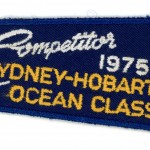 Lesley Brydon's Badge from 1975 Hobart On the OceanPictures by Lesley Brydon  Lesley Brydon (steering) and Helen  Narelle Cox  Ruth Reinhardt Trimming  Ruth Reinhardt Trimming  Ruth Reinhardt on the foredeck gybing the pole  Ruth Reinhardt on the foredeck gybing the pole  Ruth Reinhardt returning from foredeck  Ruth Reinhardt on the foredeck gybing the pole 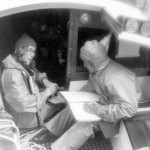 Sheila Beach (Navigator) and Vicky Willman (skipper)  Sheila Beach (navigator) taking celestial position  Sheila Beach (navigator) taking celestial position  Sheila Beach (navigator)  Sheila Beach (navigator): Plotting their position  Helen Neville in front of Tasman Island  Nancy Shaw (owner's wife) was hit on the head by the spinnaker pole 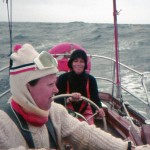 Lesley Brydon (steering) and Helen  Lesley Brydon (steering) and Helen Sailing up the Derwent towards FinishAt the Finish LineThe Canberra Times: 31st December 1975 HOBART, Tuesday. Barbarian, the first and only yacht to enter the Sydney-Hobart race with an all girl crew, finished 91st this afternoon. The girls, led by skipper Vicky Willman, were cheered as they came past the finishing line to dock in Hobart. The Royal Yacht Club of Tasmania gave Barbarian's official time as 3.54pm and elapsed time for the voyage as four days, three hours, 54 minutes 19 seconds. Navigator's Logbook TrophyExcept from Offshore Magazine March 1976 -Offshore_February-March-1976.pdf (cyca.com.au) The legibility of the logbook and the evidence of discipline in its frequent entry was an important factor in my judging. After taking these into account, together with the previously mentioned sked plots, and, finally noting the inclusion of information relating to position finding, such as R.D.F. bearings or celestial plots, it wasn't hard to reduce the stack of entries from over 50 down to four.
They were Lindsay May of Dancing Mouse, John Meekin of Skylark, Bob Snape of Polaris, and Sheila Beach, navigator of Barbarian. These were undoubtedly beautifully kept logs, and I spent quite some time before deciding that John Meekin should take the cake.
|
1971 Hobart | Barbarian (owned and skippered by Adrian F. Alle) sailed on the Sydney to Hobart Yacht Race 1971. They finished 47th our of a fleet of 78. |
|
|










